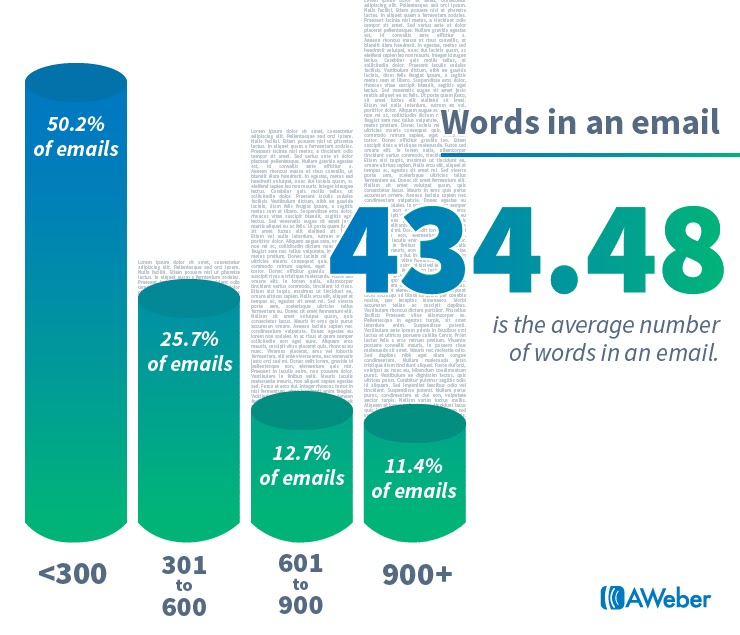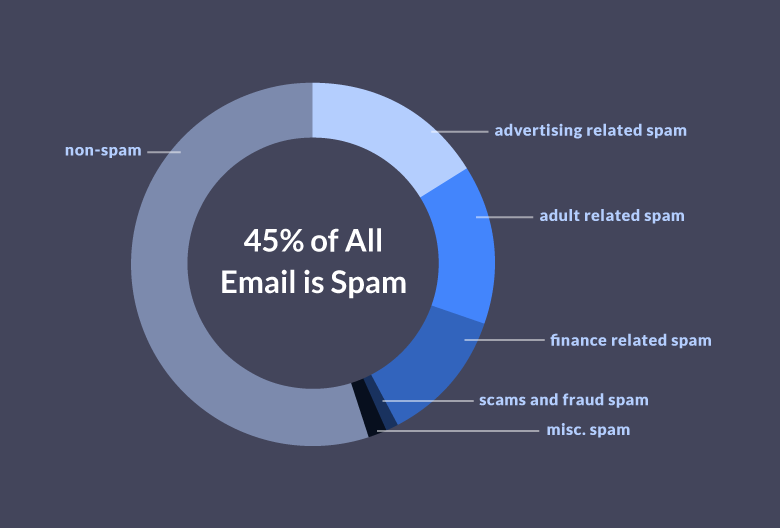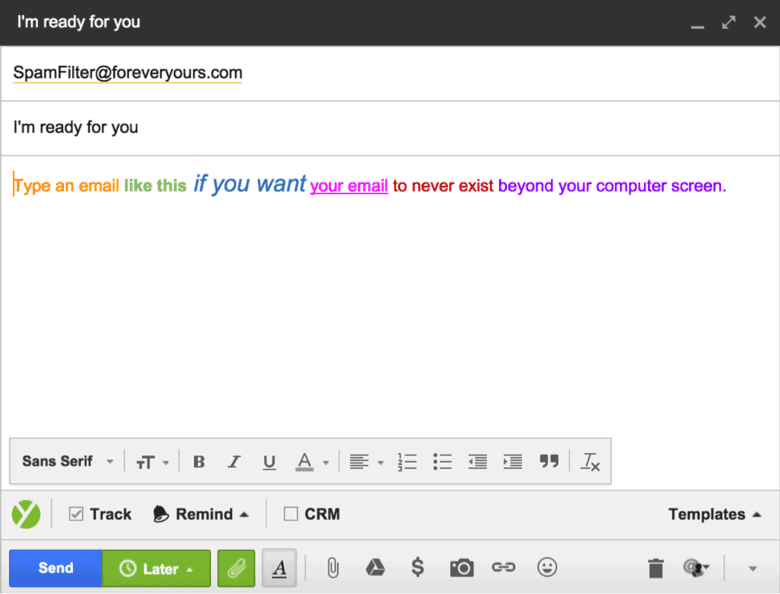Table of Contents
Email marketing is one of the most effective communication methods in any industry. It’s how we communicate directly with clients, leads, industry thought leaders, and even amongst ourselves.
However, it’s all-too-possible to end up in the spam folder if you take a misstep in email marketing. One way to do this is by using spam trigger words. Inbox providers flag certain words in the body of the email, subject line, from address, and/or preview text to notify them that the message may be unsafe.
This is a little-known fact among email marketers, and even lesser-known among businesses handling marketing on their own. Mirabel’s Marketing Manager is here to help with a few email marketing tips on how to avoid spam trigger words. We’ll also talk about SEO in email marketing and answer the age-old question: “Are email marketing buzzwords or long-tail keywords better?”
Does SEO Matter in Email Marketing?
Yes. Just like other forms of content marketing, search engine optimization (SEO) and email marketing go hand-in-hand. According to CampaignMonitor, SEO and email marketing are crucial to generating high-quality leads and driving ROI and results from within your target digital audience. As these two digital marketing strategies come together, SEO and email marketing have the same goal and can be merged to drive the ultimate conversion strategy.
How? Here’s why SEO matters in email marketing:
- A unified brand voice. Having keywords in your email marketing campaigns unifies your brand’s voice across all content. Using industry-specific keywords and your company’s tone in email marketing provides another branding opportunity to complement social media, blogging, video captions, and other content marketing.
- A solution-based marketing strategy. Integrating keywords into your email marketing campaigns helps your target audience identify if your content is beneficial to them. Does it solve their problem? Does it provide more relevant information? Is it entertaining or educational?
Keywords in email marketing presents a potential conversion opportunity and filters out lower-quality leads that may not convert into customers. After all, submitting your email address is the best conversion point.
If you’re going to include keywords in your email campaigns, do so in a natural way. Avoid keyword stuffing, which is the unrecommended practice of placing relevant keywords at random spots in copy to rank higher. Search engines catch onto keyword stuffers and now discipline the practice by lowering the content in rankings.
- A click magnet. Linking your other content marketing efforts to emails drives SEO. Internal and external links should be included in emails to boost your content’s traffic, engagement, and conversions. Social media is a great case study, as it acts as a search driver and multiplier of the effect that sending emails has.
“Incorporating social buttons into your email blasts is a good way to build search traffic through … exposure on social media. Not only can sharing email content drive searches, but it can drive traffic to your website, too.
Deb Gabor, CEO of brand strategy consultancy Sol Marketing, noted the importance of sharing the content.‘If you have high-performing emails with compelling content, highly visual content, really shareable content, and you encourage the people reading your emails to also share that content with their own networks on other social platforms with links back to your website, that can drive traffic,’ she said” to PCMag.

Should You Use Long-Tail Keywords or Buzzwords?
Long-tail keywords. Long-tail keywords, which are defined as a string of three or more keywords, convey more detailed information to your target audience compared to short general keywords. Because they’re more detailed, these keywords funnel in targeted and specific web visitor traffic that’s more likely to convert on your content (compared to generalized keywords bringing in everyday traffic).
Long-tail keywords also give you space to play in email copy and expand your brand’s storytelling capabilities.
According to SmartInsights, “40% of all search traffic on the internet is driven by long-tail keywords.” Especially in email marketing, long-tail keywords tell your audience more about your product or service than the biggest buzzwords in the marketing game. When a web visitor begins to search for a product or service to help their pain point, your specific long-tail keywords can easily rank high, allowing you to capture a high-quality lead.
For an example in email marketing, think about the buzzwords you see in daily email campaigns. Everything is “cheap,” “easy,” “free,” “new,” and “the best.”
Is it, though? Be careful not to overuse these buzzwords, as they often mirror spam trigger words that’ll land you in the wrong folder.
Consider stepping up your email marketing campaign by including long-tail keywords that are relevant to your messaging and your product or service. Instead of using those buzzwords, we’d say “affordable marketing automation software” or “marketing automation software for B2B.”
Can You Use Long-Tail Keywords and Buzzwords Together?
Like SEO and email marketing, it’s possible to use long-tail keywords and buzzwords in email copy. While long-tail keywords create a niche and higher-quality leads, buzzwords still capture a general industry inquiry. Using both allows your emails to sound more natural and avoid keyword stuffing.
Here’s how to use buzzwords and long-tail keywords in email marketing campaigns without triggering the spam folder:
- Questions. Using buzzwords in your email subject lines can pique your audience’s attention, especially when followed by long-tail keywords in your email content. A great example is for a content offer: Get Our Best Ebook for Email Marketing Beginners.
- Deadlines. Carefully treading between the Primary and Promotions folders, deadlines are an incentivizing buzzword. If you do it right, deadlines in email subject lines paired with long-tail keywords can increase open and click rates while adding value to your SEO strategy.
- Numbers. An effective way to communicate the impact of your brand is by including numbers. Numbers display quick facts, data, and statistics that are easy-to-read in email subject lines and preview texts. Using numbers saves space in copy and is consistently ranked as one of the best SEO techniques.
Mixing buzzwords and long-tail keywords diversifies your copy in email campaigns. It avoids repetition in branding and steers clear of email spam trigger words. This complementary pair also pads your SEO strategy and increases open and click-through rates, as your audience engages with your emails.
What Are Email Spam Trigger Words?
As mentioned before, ActiveCampaign, a marketing automation and CRM platform, defines email spam trigger words as “keywords or phrases that email providers see as red flags.” They often mark your emails as content that’s suspicious or invalid. Spam trigger words are closely associated with phishing scams, honeypot traps, viruses, and other unsavory emails.

The Most Common Spam Trigger Words
About 14.5 billion spam emails are sent every day, according to Propeller, a CRM for Gmail users. Because of this, inbox providers are becoming stricter with the guidelines on what’s allowed in their users’ inboxes.

One of the easiest ways to avoid the spam filter is by choosing your words wisely. AutoPilot HQ, a marketing automation software, categorized email spam words in 2020 into six descriptions:
1. Sleazy. Email spam words in subject lines may overstep your audience’s boundaries. Sometimes, these words suggest added value of your product in an intrusive way. Some “sleazy” spam trigger words to avoid include the following:
- As seen on…
- Do it today!
- What are you waiting for?
- Order now!
- Order today!
- Click below!
If you can avoid these spam trigger words and talk about your content in a less invasive way, you increase the possibility of your content staying out of spam folders.
2. Needy. Exaggerated claims in your email subject line may steer your audience away from your content. These lofty claims illustrate a potential overcompensation for the actual value of your content. Some “needy” spam trigger phrases to avoid include the following:
- Bargain
- Best price
- Free (gift)!
- Satisfaction guaranteed
- Incredible deal
- Join millions of users
- For instant access
- You won’t believe your eyes!
3. Manipulative. Email spam words in 2020 can reflect unnecessary haste imposed on your digital audience. Constructing an illusive situation that’s urgent when there’s nothing wrong comes across to your audience as manipulative. This is the fine line we mentioned using deadlines. Spam trigger words to avoid in the manipulative category include but are not limited to the following:
- Act now!
- Apply now!
- Instant
- Limited time
- Urgent
- Once in a lifetime
- Offer expires
- While [insert product] lasts
An organic relationship with your audience will reflect them taking the appropriate time to read and engage with your content instead of imposing a rush on them.
4. Far-fetched. Email spam words can sound too good to be true. These unbelievable spam trigger words damage your credibility as a brand. They often promise pyramid or multi-level marketing schemes for finances (offering side jobs or investments, increasing sales), physical appearance (losing weight, getting rid of wrinkles), or real estate opportunities (vacation offers, timeshares).
Avoid spam trigger words like the following:
- Earn extra cash!
- Free money
- No hidden costs
- Risk-free
- No fees!
- Billions
- Additional income
- Be your own boss
- Eliminate bad credit
5. Shady. A few words associated with legally or ethically questionable behavior can trigger your email as spam in 2020. Refrain from the following words to keep your email campaigns out of spam filters:
- Score
- Social Security Number
- Spam
- Unsolicited
- Warranty
6. Cheap. Another fine line in email copy is the difference between your product or service being “affordable” and being “low cost” or “cheap.” Describing the pricing of your product or service is helpful to your audience, especially those at the end of their buying process. However, using less-than-savory words to describe affordability in emails may instead indicate your product has low or no value. Avoid the following spam trigger words:
- No purchase necessary
- Winner
- Free info
- Free membership
- Dramatically reduced
- Avoid bankruptcy
- Congratulations!
- Credit card offers
- Get out of debt!
Unknowingly using spam trigger words in emails is common. It’s important to consider the copy you use, from the subject line to the body of the email. You may be using these words without malice or understanding of their negative connotation to inbox providers.
Carefully selecting your email subject line is the easiest way to avoid spam filters from taking hold of your content. Autopilot HQ also has a comprehensive list of spam trigger words in 2020 to avoid in email marketing.
HubSpot’s slightly older list breaks it down by category: Commerce, personal, employment, financial, general, greetings, marketing, medical, numbers, offers, free, descriptions/adjectives, sense of urgency, and nouns.
How to Keep Your Email Out of Spam Folders
Remember that spam filters are more complicated in 2020 than ever before. They’re catching obvious traps along with innocent campaigns that get caught on a trigger word or phrase. If you fall into the latter category trying to boost SEO, consider how and where your copy fits into the campaign. To help, our marketing automation software recommends avoiding the following:
- All capital letters
- Embedded forms, especially in the email body
- Exclamation marks, especially in email subject lines
- Spelling or grammar mistakes

How to Check for Spam Trigger Words
If you struggle to write email subject lines, use a spam words checker. With these digital marketing tools, you can avoid spam words in your email, craft appealing subject lines, and increase open and click rates. Learn how to check for spam trigger words in subject lines with recommendations from Mirabel’s Marketing Manager:
- Test Subject by Zurb. This email subject line tool tests its appearance on the most popular mobile devices. The goal is to avoid cutting off your subject line at an inopportune place. This digital tool gives you a real-time look at how your sender name, subject line, and preview text will look on certain iPhone and Samsung models.
- Spam Check by Postmark. This free email subject line tool tests overall spam score. In a marketing world where email deliverability is key, avoiding the spam folder is Rule No. 1. Spam Check by Postmark, a transactional email service for web apps, allows you to enter your subject line, preview text, and copy to see what may trigger spam filters. It’ll give you recommendations on how to avoid the spam filter like adding headers.
- Email Subject Line Grader by Net Atlantic. As a free digital tool, Email Subject Line Grader determines subject line type, whether it’s generic, how-to, or list. It calculates word and character count, as well as word mixture and balance. It checks for copy with emotion, action, and power to entice recipients to open your email.
- Omnisend Email Subject Line Tester. Boost your open rates with this free email marketing tool. It considers word and character count; helpful and negative words (with a link to a list of words to increase open rates); spam folder alerts, including spammy words and characters, as well as excessive punctuation; scannability; and mobile and desktop previews.
When considering your next email marketing strategy, understand that emails contribute to SEO and vice versa, bringing more traffic and engagement to your content from multiple sources.
To get the most out of this email strategy, pay special attention to the language you use in the subject line, preview text, and body. Avoid spam trigger words and play around with a mixture of buzzwords and long-tail keywords. When in doubt, use an email marketing tool to double-check your strategy.
For more information about the basics of email marketing, download the free white paper from Mirabel’s Marketing Manager.
Kelly Jacobson contributed to this blog.
SEE FOR YOURSELF
Watch an overview to learn how B2B marketing automation by Mirabel Technologies can help you increase traffic, optimize your funnel, drive more leads, improve conversions, and boost ROI — at a price you can afford!


